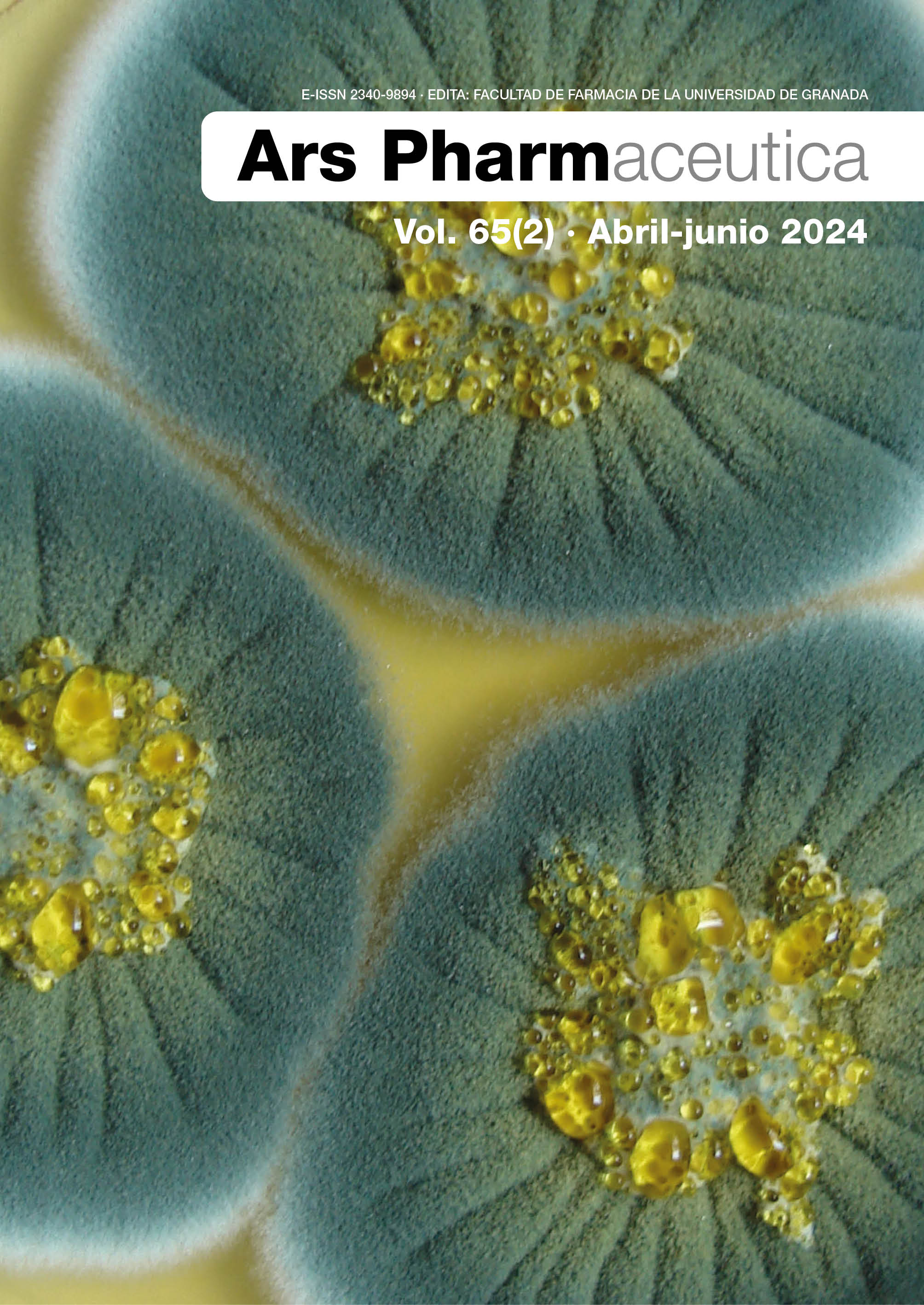Effect of analytical methodologies on the quantification of epinephrine bitartrate according to USP-43 and USP-44
DOI:
https://doi.org/10.30827/ars.v65i2.29187Keywords:
epinephrine, USP, quantificationAbstract
Introduction: Epinephrine bitartrate, also known as epinephrine, is an important pharmaceutical ingredient in the treatment of various diseases, but its accurate measurement is essential to ensure the safety of the drug. The United States Pharmacopeia (USP) sets the standards for its analysis, but the choice of method affects the precision of the measurements. This study investigates how different methods affect the measurements of epinephrine bitartrate based on USP-43 and USP-44, which have significant implications for drug quality and regulation in the field.
Method: The volumetric method and chromatographic method were chosen for comparison. High-purity epinephrine bitartrate samples that met USP-43 and USP-44 standards were used.
Results: The results obtained by both methods are compared with and evaluated according to the specification limits defined by USP-43 and USP-44. The values obtained for some parameters, such as the concentration and purity of epinephrine tartrate, vary considerably between the different analytical methods.
Conclusions: This study highlights the importance of carefully selecting analytical methods when evaluating epinephrine tartrate according to USP-43 and USP-44 guidelines. The choice of technology affects the results and, therefore, the quality and safety of the pharmaceutical products containing this substance. It is recommended to validate the method in each laboratory and compare the results with USP standards.
Downloads
References
Kumar M, Bhatia R, Rawal RK. Applications of various analytical techniques in quality control of pharmaceutical excipients. J Pharm Biomed Anal. 2018;157:122-136. doi:10.1016/j.jpba.2018.05.023 DOI: https://doi.org/10.1016/j.jpba.2018.05.023
Ramos-Martínez B, Alonso-Herreros JM, Martín de Rosales-Cabrera AM. The importance of quality control in raw materials used in pharmaceutical formulations. Farm Hosp. 2020;44(1):32-33. doi:10.7399/fh.11347
Lau CBS, Yue GGL, Lau KM, et al. Method establishment for upgrading chemical markers in pharmacopoeia to bioactive markers for biological standardization of traditional Chinese medicine. J Tradit Complement Med. 2018;9(3):179-183. doi:10.1016/j.jtcme.2018.09.003 DOI: https://doi.org/10.1016/j.jtcme.2018.09.003
Dispas A, Sacré PY, Ziemons E, Hubert P. Emerging analytical techniques for pharmaceutical quality control: Where are we in 2022? J Pharm Biomed Anal. 2022;221:115071. doi:10.1016/j.jpba.2022.115071 DOI: https://doi.org/10.1016/j.jpba.2022.115071
Bravo-Urquiola M, Arends A, Montilla S, et al. Ventajas de la Técnica de Cromatografía Líquida de Alta Presión (HPLC-CE) en el estudio de Hemoglobinopatías en Venezuela. Investig Clínica. 2004;45(4):309-315.
Stability by Design - Guidelines for Assessing & Controlling Physical Stability - ECA Academy. Accessed October 10, 2023. https://www.gmp-compliance.org/gmp-news/stability-by-design-guidelines-for-assessing-controlling-physical-stability
The Complexity of Setting Compendial Specifications for Excipient Composition and Impurities | USP. Accessed October 10, 2023. https://www.usp.org/excipients/stimuli-article-2018
Lumieres - Repositorio institucional Universidad de América: Principios básicos de la cromatografía líquida de alto rendimiento para la separación y análisis de mezclas. Accessed October 10, 2023. https://repository.uamerica.edu.co/handle/20.500.11839/7731
Andrade JC de. Química analítica básica: volumetria de neutralização - conceitos e curvas de titulação. Rev Chemkeys. 2020;2:e020002-e020002. doi:10.20396/chemkeys.v2i.13737 DOI: https://doi.org/10.20396/chemkeys.v2i.13737
Byrn S, Pfeiffer R, Ganey M, Hoiberg C, Poochikian G. Pharmaceutical Solids: A Strategic Approach to Regulatory Considerations. Pharm Res. 1995;12(7):945-954. doi:10.1023/A:1016241927429 DOI: https://doi.org/10.1023/A:1016241927429
USP 44-NF 39 – Last Print Edition | USP-NF. Accessed October 10, 2023. https://www.uspnf.com/notices/usp-nf-final-print-edition
USP 43-NF 38 – Last Print Edition | USP-NF. Accessed October 10, 2023. https://www.uspnf.com/notices/usp-nf-final-print-edition
Rendón-Macías ME, Zarco-Villavicencio IS, Villasís-Keever MÁ. Métodos estadísticos para el análisis del tamaño del efecto. Rev Alerg México. 2021;68(2):128-136. doi:10.29262/ram.v658i2.949 DOI: https://doi.org/10.29262/ram.v658i2.949
Tarrillo Peralta LK. Elaboración de un Procedimiento Operativo Estándar de calibración de material volumétrico de vidrio para el Centro de Control de Calidad de Medicamentos de la Universidad Nacional de Trujillo. Univ Nac Trujillo. Published online 2019. Accessed October 10, 2023. https://renati.sunedu.gob.pe/handle/sunedu/2995021
Pharmacopeial Forum Table of Contents | USP-NF. Accessed October 10, 2023. https://www.uspnf.com/pharmacopeial-forum/pf-table-contents
de Jesús Pérez Saavedra J, Rincón Arce S. Ultramicrovaloración potenciométrica de sulfato ferroso amoniacal con tres diferentes oxidantes. Educ Quím. 2010;21(1):70-77. doi:10.1016/S0187-893X(18)30075-2 DOI: https://doi.org/10.1016/S0187-893X(18)30075-2
Ruiz Castillo EJ, Mayorga Peña M del C del. Herramientas de manufactura esbelta aplicadas a una propuesta de mejora en un laboratorio químico de análisis de minerales de una empresa comercializadora. Published online April 24, 2014. Accessed October 10, 2023. https://tesis.pucp.edu.pe/repositorio//handle/20.500.12404/5270
Trigo Orsini ML, Aban Aramayo EA. Validación del método analítico por cromatografía líquida de alta resolución para la cuantificación de conservantes en jugo de naranja. Revista CON-CIENCIA. noviembre de 2020;8(2):63–76.
Argota Pérez G, Argota Coello H. Aplicación de la prueba t-Student para la competencia técnica y trazabilidad analítica: ejemplo de estudio. Rev Campus. 2018;23(26):145-150. DOI: https://doi.org/10.24265/campus.2018.v23n26.04
Flores-Ruiz E, Miranda-Novales MG, Villasís-Keever MÁ. El protocolo de investigación VI: cómo elegir la prueba estadística adecuada. Estadística inferencial. Rev Alerg México. 2017;64(3):364-370. doi:10.29262/ram.v64i3.304 DOI: https://doi.org/10.29262/ram.v64i3.304
t-Test, Chi-Square, ANOVA, Regression, Correlation... Accessed October 10, 2023. https://datatab.es/tutorial/unpaired-t-test
Núñez-Barragán KI, Vallejo-Rosero KA. Estabilidad de la lidocaína con epinefrina al 2% al someterse a temperatura de 37 ° c y 42 ° c. Dominio Las Cienc. 2017;3(1):35-49. doi:10.23857/dom.cien.pocaip.2017.3.1.35-49 DOI: https://doi.org/10.23857/dom.cien.pocaip.2017.3.1.35-49
Downloads
Published
How to Cite
Issue
Section
License
Copyright (c) 2024 Lennin Roswell Rodriguez Saavedra, JUNIOR SANCHEZ, FRANCISCO SAAVEDRA, LUIS CHAVEZ, LEANDRO SANDOVAL

This work is licensed under a Creative Commons Attribution-NonCommercial-ShareAlike 4.0 International License.
The articles, which are published in this journal, are subject to the following terms in relation to the rights of patrimonial or exploitation:
- The authors will keep their copyright and guarantee to the journal the right of first publication of their work, which will be distributed with a Creative Commons BY-NC-SA 4.0 license that allows third parties to reuse the work whenever its author, quote the original source and do not make commercial use of it.
b. The authors may adopt other non-exclusive licensing agreements for the distribution of the published version of the work (e.g., deposit it in an institutional telematic file or publish it in a monographic volume) provided that the original source of its publication is indicated.
c. Authors are allowed and advised to disseminate their work through the Internet (e.g. in institutional repositories or on their website) before and during the submission process, which can produce interesting exchanges and increase citations of the published work. (See The effect of open access).























